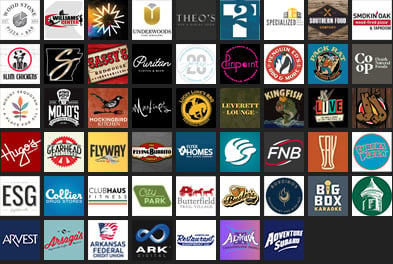
A&P Commissioners Hannah Withers (left) and Ching Mong (center) speak with Jeannette Balleza, director of The ARK Startup Accelerator Challenge inside the Fayetteville Town Center before a grant award meeting in 2014.
Photo: Todd Gill, Flyer staff
The Fayetteville Advertising and Promotion Commission is considering an overhaul of its process for distributing grant funds.
Members of the commission on Monday heard the beginnings of a proposal from Executive Director Molly Rawn that would add some clarity to the grant process, which has in the past been criticized for being confusing and difficult to manage.
“I want to be abundantly clear moving forward that when people apply for these grants they understand what the expectations are and what we expect to see,” Rawn said.
Twice each year, the commission gives grant funds to groups who request financial help with promoting or starting an event. The group awarded about $208,000 in 2016, but has given as much as $424,000 in previous years.
Fayetteville A&P grants
| Spring | Fall | Total | |
|---|---|---|---|
| 2016 | $103,484 | $104,934 | $208,418 |
| 2015 | $77,830 | $138,492 | $216,322 |
| 2014 | $80,900 | $155,922 | $236,822 |
| 2013 | $161,950 | $261,880 | $423,830 |
| 2012 | $159,200 | $145,328 | $304,528 |
| 2011 | $61,800 | $182,828 | $244,628 |
| 2010 | $149,292 | $222,176 | $371,468 |
Source: Staff report
By restructuring the grant process, Rawn said the commission could be more strategic with the way it gives away funds to ensure the investments are focused on the five areas that encompass the commission’s goal to promote Fayetteville and enhance the city’s brand: performing arts, visual arts, culinary arts, sports and recreation, and heritage.
Rawn’s proposal includes three categories of grant programs, two of which would be application-based and a third that would be given to groups who are nominated.
Through the first two programs, applications could request funds for either innovation grants or capacity grants.
Innovation grants would help jumpstart new events or expand existing ideas, while capacity grants would be reserved for ongoing or seasonal event organizers that have established themselves as consistent contributors to Fayetteville’s overall brand.
Innovation grants would be limited to $5,000 per applicant, and would include no more than a total of $50,000 per year. Rawn said innovation grants would initially be given twice each year – $25,000 in both the spring and fall – but that the program could be expanded to include quarterly awards in the future.
A revamped application process would require innovation grant hopefuls to specify which of the five focus areas their event falls into while also stating their definition of success for their particular project. About half of their funds would be distributed 30 days before the event, with the remainder coming only after a post-event report is submitted.
Rawn said she hasn’t yet determined dollar amounts for capacity grants, but said they would be larger awards closer to the $10,000 range.
As for the third category, Rawn called it a “big audacious idea award” that would go to organizations working to advance and strengthen the element of place in Fayetteville who show extraordinary originality and dedication in their creative pursuits.
“I think we should have…a significant amount of funding that we give away once a year that is just for a really big, awesome showstopper,” Rawn said. “A new thing that is going to have an impact on tourism and on the culture of this city.”
Rawn said details of both the capacity and “big audacious idea award” programs aren’t fully developed, but would be ready for presentation during the commission’s next regular meeting on March 21.
Commissioners Robert Rhoads, Ching Mong, Matthew Behrend and Adella Gray on Monday seemed to be on board with making changes to the overall grant process.
“For me, this would provide more structure, which is always good,” said Gray, who, along with Matthew Petty, is one of two City Council members who serve on the commission.
Petty, who is chair of the commission, agreed.
“The grant program we have in place now started as a way to disperse our operating surplus on a biannual basis and the current guidelines really reflect that in that they weren’t really guidelines at all, but rather suggestions on a piece of paper,” said Petty. “I really think that what’s being proposed here marks a new level of maturity for the commission we serve on.”

